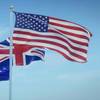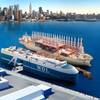Sonar Imagery Assists Bow Mariner Investigation
The Coast Guard has released two multi-beam sonar images taken by the NOAA ship Rude of the sunken tanker Bow Mariner. The images, taken March 4, are among a suite of side-scan sonar and multi-beam images provided by RUDE to the Coast Guard for use in its investigation of the cause of the explosion that sank the vessel on February 28.
Rude (pronounced Rudy) found the wreck on March 2, and initial side-scan imagery showed the placement and orientation of Bow Mariner. However, Rude had to discontinue operations because of bad weather. The ship returned to the scene during better weather and collected additional sonar imagery on Thursday, March 4, for the Coast Guard to review. Multi-beam sonar systems provide fan-shaped coverage of the seafloor similar to side-scan sonars, but the output data is in the form of depths rather than images. Instead of continuously recording the strength of the return echo, the multi-beam system measures and records the time for the acoustic signal to travel from the transmitter to the seafloor (or object) and back to the receiver. RUDE’s multi-beam system is attached to its hull, rather than being towed like a side scan. Therefore, the coverage area of the seafloor is dependent on the depth of the water, typically two to four times the water depth. The NOAA fleet of research and survey ships and aircraft is operated, managed and maintained by NOAA Marine and Aviation Operations. NMAO includes commissioned officers of the NOAA Corps and civilians. The NOAA Corps is the nation’s seventh and smallest uniformed service, and, as part of NOAA, is under the U.S. Department of Commerce. The Corps is composed of officers—all scientists or engineers—who provide NOAA with an important blend of operational, management and technical skills that support the agency’s environmental programs at sea, in the air, and ashore.













